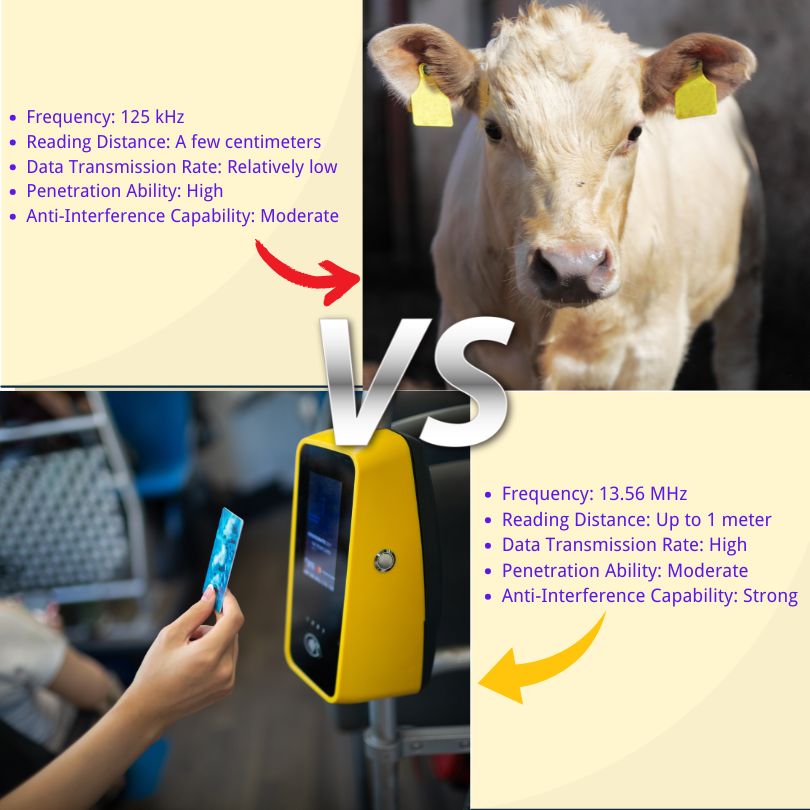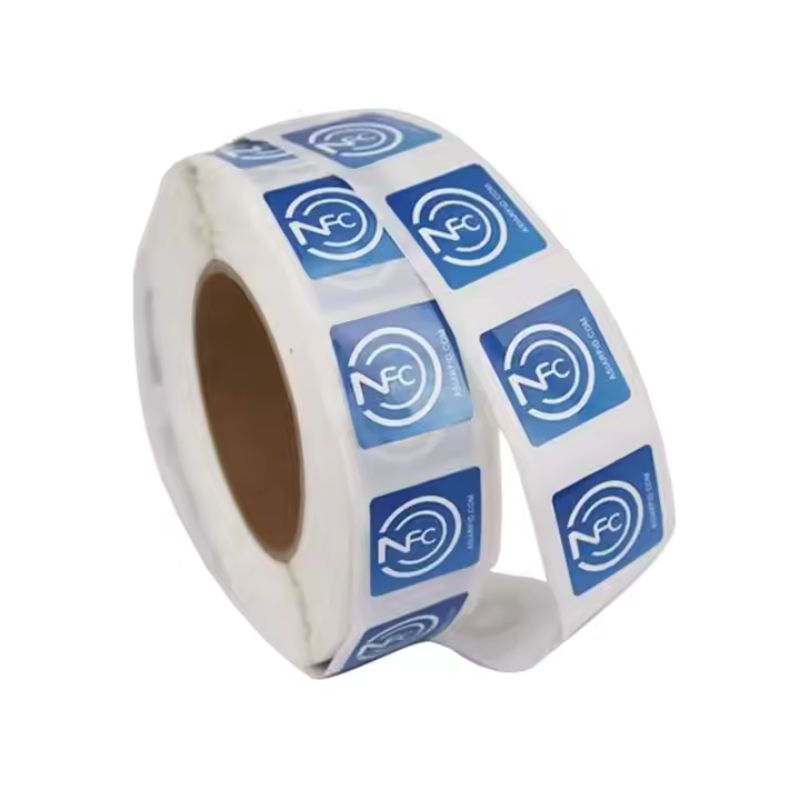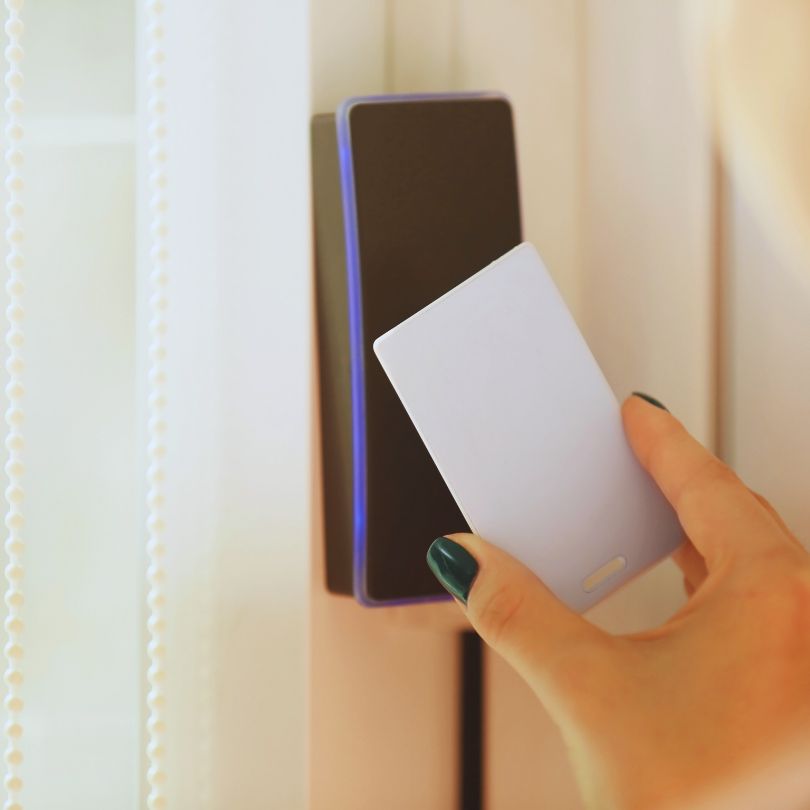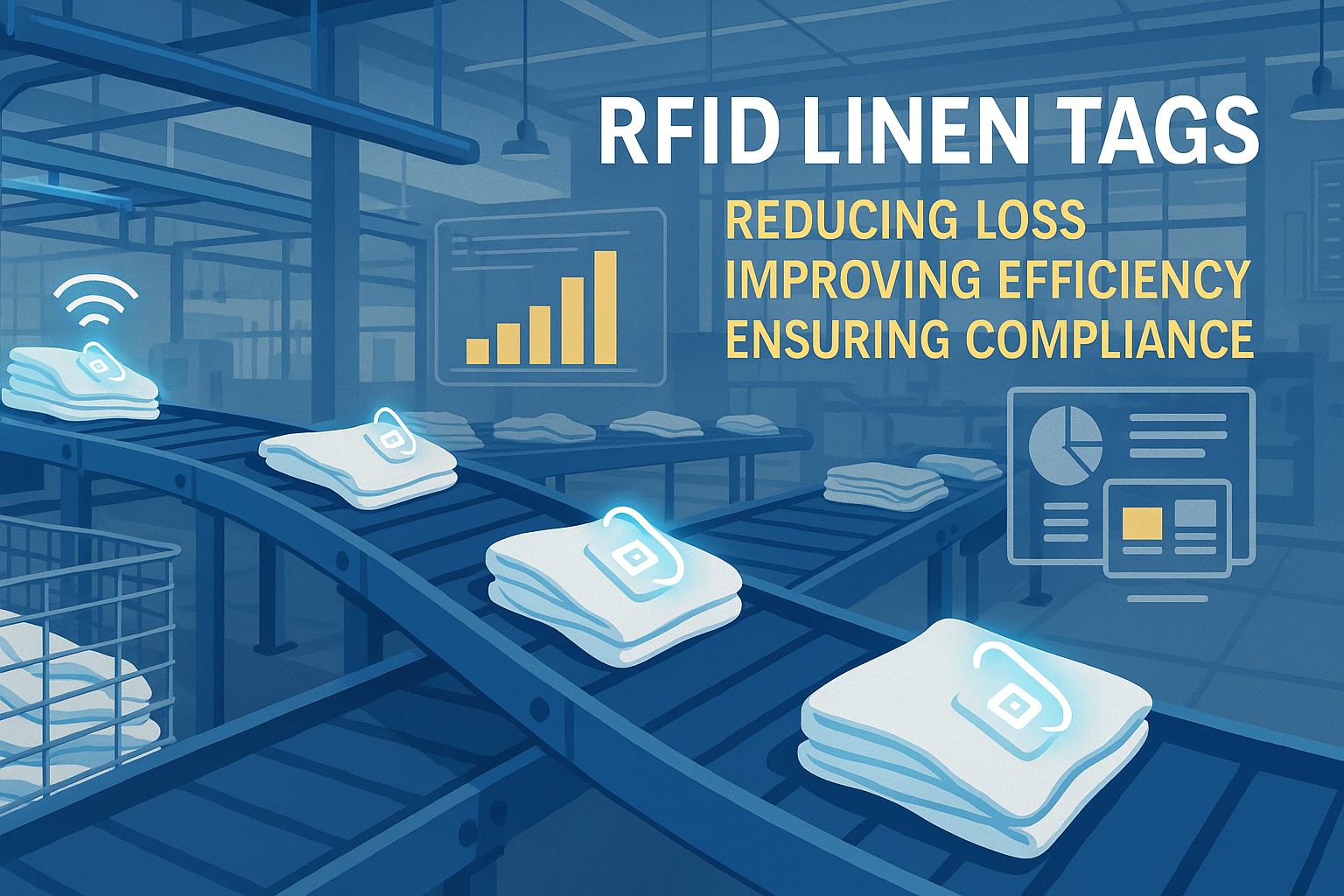
Förstå skillnaderna mellan 13,56 MHz och 125 kHz RFID-taggar
Innehållsförteckning
Förstå skillnaderna mellan 13,56 MHz och 125 kHz RFID-taggar

Vad RFID-frekvens egentligen betyder (LF vs HF)
RFID-system använder radiovågor för att kommunicera mellan Taggar och läsare. Frekvensen de använder påverkar hur långt de kan läsa, hur snabbt de skickar data, hur de beter sig i närheten av metall eller vatten och vilken typ av data de kan lagra.
Här är kärnidén:
Lågfrekvens (LF) = 125 kHz RFID-taggar
- Kort räckvidd
- Långsammare datahastighet
- Utmärkt prestanda nära metall eller vätskor
- Enkel, robust och prisvärd
Högfrekvens (HF) = 13,56 MHz RFID-taggar - Längre räckvidd
- Snabbare datahastighet
- Mer avancerad säkerhet
- Kompatibel med NFC och smartphones
13,56 MHz mot 125 kHz
| Särdrag | 13,56 MHz RFID-taggar | 125 kHz RFID-taggar |
|---|---|---|
| Frekvens | 13,56 MHz (HF) | 125 kHz (LF) |
| Läs Range | Upp till 1 meter | 2-10 cm |
| Dataöverföringshastighet | Hög | Låg |
| Prestanda nära metall | Måttlig | Stark |
| Säkerhet | Stöder kryptering, ömsesidig autentisering | Grundläggande, vanligtvis ingen kryptering |
| NFC / Smartphone-stöd | Ja | Inga |
| Kosta | Högre | Lägre |

Säkerhet: Är en frekvens säkrare?
125 kHz RFID-taggar används ofta i äldre system och använder vanligtvis fasta unika ID-nummer utan kryptering. Det gör dem lätta att klona med vanliga enheter. De fungerar bra för system med låg risk, men uppfyller inte moderna säkerhetsstandarder.
13,56 MHz RFID-taggar, särskilt MIFARE- eller DESFire-kort, stöder:
- Kryptering
- Ömsesidig autentisering
- Säker minneslagring
- Flera applikationer på ett enda kort
Slutsats: - Använd 125 kHz RFID-taggar för låga säkerhetsbehov (som skåpnycklar, tidsklockor).
- Välj 13,56 MHz för åtkomstkontroll, betalningar eller andra system som lagrar personuppgifter.
NFC och smartphone-kompatibilitet
Om ditt projekt involverar telefoner fungerar inte 125 kHz RFID-taggar.
Endast 13,56 MHz RFID-taggar stödjer NFC (Near Field Communication) – den teknik som används vid mobila betalningar, incheckningar och tap-to-pair-funktioner.
De flesta smartphones kan läsa och skriva NFC-taggar med 13,56 MHz, vilket gör denna frekvens idealisk för:
- Digitala biljetter
- Incheckning vid evenemang
- Smarta affischer
- Lojalitetskort
- Kontaktlös mobil ID
Om smartphone-stöd är viktigt är 13,56 MHz ditt enda val.
Verkliga användningsfall per bransch
| Bransch / Tillämpning | 125 kHz RFID-taggar | 13,56 MHz RFID-taggar |
|---|---|---|
| Åtkomstkontroll | Grundläggande passersystem, äldre dörrar | Säkra autentiseringsuppgifter, moderna ID-kort |
| Kollektivtrafik / Biljettförsäljning | Stöds inte | MIFARE/NFC-baserade resekort |
| Djurspårning | Används ofta på grund av vävnadsgenomträngning | Sällsynt |
| Industriell automation | Pålitlig nära metall/vätska, robust användning | Mindre vanligt i tuffa miljöer |
| Sjukvård | Inte idealiskt för patient- eller medicineringuppföljning | Bättre för säker ID- och tillgångsmärkning |
| Bibliotek / Arkiv | Sällsynt | Populärt för bokspårning och utcheckningar |
| Marknadsföring/Evenemang | Ej tillämpligt | Smarta affischer, NFC-evenemangspass |
| Fordonsstöldskydd | Inbyggda 125 kHz RFID-taggar i nycklar/tändningslås | Används inte |

Hur du väljer mellan 13,56 MHz och 125 kHz för ditt projekt
Använd denna checklista för att begränsa ditt val:
1. Säkerhetsnivå
- Behöver du kryptering eller säker åtkomst? → Välj 13,56 MHz
- Låg risk spårning eller grundläggande ID? → 125 kHz kan vara tillräckligt.
2. Miljö
- Hög störning, metall eller vätska i närheten? → 125 kHz fungerar bättre
- Rent kontor eller inomhusutrymme? → Båda fungerar; välj utifrån funktionerna.
3. Smartphone-integration
- Vill du att användarna ska skanna med sina telefoner? → Endast 13,56 MHz stöder detta.
4. Budget
- 125 kHz-taggar är billigare i inköp
- Men 13,56 MHz erbjuder mer långsiktigt värde om du behöver funktioner eller säkerhet.
Använder du fortfarande 125 kHz RFID-taggar? Uppgradera eller behålla?
125 kHz RFID-taggar används fortfarande i stor utsträckning inom:
- Äldre åtkomstkontrollsystem
- Fabriksgolvsverksamhet
- Märkning av boskap
- Automatiska stöldskyddssystem
Men om du klarar av det: - Personalens referenser
- Betalsystem
- ID-kort för flera användningsområden
- NFC-integration
... då kan det vara dags att byta.
Uppgraderingsvägar:
- Installera dubbelfrekvensläsare
- Utfärda kombinationskort (stöder både 13,56 MHz och 125 kHz)
- Gradvis införande: stöd för båda systemen under migreringen
Vanliga frågor om 13,56 MHz kontra 125 kHz RFID
Är 13,56 MHz samma sak som NFC?
Ja, NFC är en typ av 13,56 MHz RFID. De flesta smartphones stöder det.
Kan en läsare läsa båda frekvenserna?
Vanligtvis inte. Du behöver en läsare med dubbla tekniker för att hantera båda.
Vilken tagg har längre räckvidd?
13,56 MHz har i allmänhet en längre läsräckvidd (upp till 1 meter). 125 kHz är begränsad till några centimeter.
Vilket ska jag använda för åtkomstkontroll?
För moderna, säkra åtkomstsystem rekommenderas starkt 13,56 MHz.
Varför har 13,56 MHz och 125 kHz RFID-taggar olika läsavstånd?
Skillnaden i läsavstånd beror främst på arbetsfrekvensen. Högre frekvenser som 13,56 MHz har ett större räckvidd, medan lägre frekvenser som 125 kHz är optimerade för kortare avstånd.
Vilken RFID-tagg är mer lämplig för metall- eller flytande miljöer?
125 kHz RFID-taggar är mer effektiva i miljöer med metaller eller vätskor på grund av deras överlägsna penetreringsförmåga.
Påverkar kostnaden för RFID-taggar valet?
Ja, 125 kHz RFID-taggar är generellt sett mer kostnadseffektiva, vilket gör dem till ett lämpligt alternativ för budgetmedvetna applikationer. Men valet bör även beakta prestandakrav och applikationsmiljöer.
Viktiga standarder och chiptyper
13,56 MHz (HF)
- ISO/IEC 14443: Används i kontaktlösa kort (MIFARE, DESFire)
- ISO/IEC 15693: Längre räckvidd, används i bibliotek och logistik
- ISO 18000-3: Spårning på artikelnivå
125 kHz (LF)
- Proprietära format, ofta med fast ID (t.ex. EM4100, HID Prox)
- Används främst i äldre system och grundläggande applikationer
Slutliga slutsatser
Om du fortfarande funderar på vilket alternativ du ska välja, här är en sammanfattning:
Använd 125 kHz RFID-taggar för:
- Hårda förhållanden (metall/vätska)
- Applikationer med låg säkerhet
- Budgetmedvetna installationer
- Äldre system
Använd 13,56 MHz RFID-taggar för:
- Mobil-/NFC-stöd
- Säker åtkomst och betalning
- Multifunktionskort
- Framtidssäkra system
Båda har sin plats – men du bör välja utifrån användningsområdet, inte bara utifrån kostnad eller vana.
Kommentarer
Heta produkter

Vad är RFID-avfallshantering?
Föreställ dig en stad där varje sopkärl talar – inte bokstavligt talat – utan genom ett litet chip som meddelar systemet när det är fullt, när det töms och vart det har tagits. Det är vad RFID-avfallshantering gör idag.

Vad är bultförseglingar och deras användningsområden? | Komplett guide
Inom global handel och logistik spelar bultförseglingar en avgörande roll för att säkerställa godssäkerhet och efterlevnad. Dessa små men kraftfulla enheter är utformade för att låsa fraktcontainrar, släpvagnar och lastdörrar med en manipuleringssäker mekanism.

Vad är ett RFID-kortskydd? Fördelar, användningsfall och köpguide
RFID-teknik (Radio Frequency Identification) finns överallt: i dina kreditkort, ID-brickor, färdbevis, hotellrumsnycklar och mycket mer. Det ger snabbhet och bekvämlighet, men det öppnar också dörren för en ny typ av digital stöld som kallas "skimming". Det är där ett RFID-kortskydd kommer in i bilden.

RFID-armband för evenemang: Guide för storköp för arrangörer
RFID-armband för evenemang håller på att bli lösningen för arrangörer som behöver snabbare inträde, bedrägeribekämpning och kontantlösa betalningar på konserter, festivaler och idrottsarenor. Till skillnad från pappersbiljetter eller QR-koder använder dessa smarta armband inbäddade chips för att effektivisera åtkomst, säkra transaktioner och förbättra gästupplevelsen.

Hur RFID-taggar på vindrutan förbättrar passerkontroll och vägtullsystem för fordon
I dagens snabba värld måste fordonsidentifiering vara snabb, säker och kontaktlös. En RFID-tagg på vindrutan ger exakt det - ett tillförlitligt sätt att hantera vägtullar, parkering och gated access utan att stoppa fordon.

Fördelarna med RFID-linnetiketter i kommersiella tvätterier
Att hantera tvätten på sjukhus, hotell eller stora tvätterier är ett stort jobb. Varje dag tvättas, sorteras och skickas tusentals lakan, handdukar och uniformer tillbaka ut. Men problem som borttappade sängkläder, sorteringsmissar och manuell räkning kan kosta företagen mycket pengar. Till exempel kan medelstora hotell förlora över $200.000 varje år på grund av borttappade sängkläder.
Det är där RFID Linen Tags kommer in i bilden.
Taggar
RELATERADE BLOGGAR

Vad är RFID-avfallshantering?
Föreställ dig en stad där varje sopkärl talar – inte bokstavligt talat – utan genom ett litet chip som meddelar systemet när det är fullt, när det töms och vart det har tagits. Det är vad RFID-avfallshantering gör idag.

Vad är bultförseglingar och deras användningsområden? | Komplett guide
Inom global handel och logistik spelar bultförseglingar en avgörande roll för att säkerställa godssäkerhet och efterlevnad. Dessa små men kraftfulla enheter är utformade för att låsa fraktcontainrar, släpvagnar och lastdörrar med en manipuleringssäker mekanism.

Vad är ett RFID-kortskydd? Fördelar, användningsfall och köpguide
RFID-teknik (Radio Frequency Identification) finns överallt: i dina kreditkort, ID-brickor, färdbevis, hotellrumsnycklar och mycket mer. Det ger snabbhet och bekvämlighet, men det öppnar också dörren för en ny typ av digital stöld som kallas "skimming". Det är där ett RFID-kortskydd kommer in i bilden.




